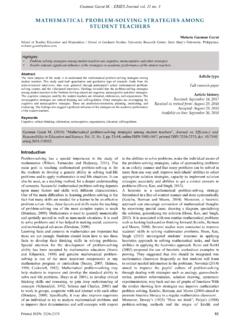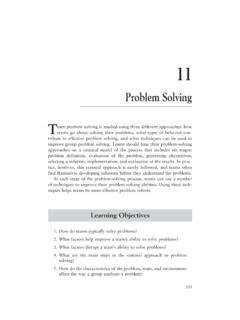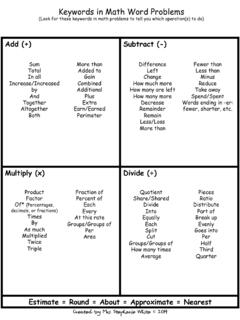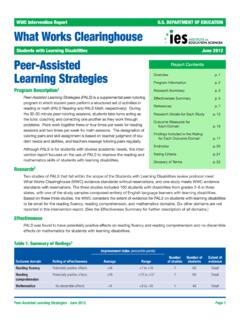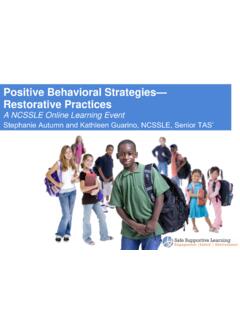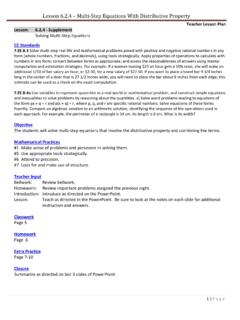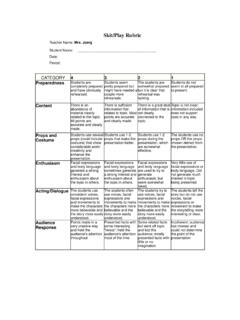Transcription of Fostering Student Engagement: Creative Problem-Solving in ...
1 Fostering Student Engagement: Creative Problem-Solving in Small Group Facilitations 2015 CELT Vol. VIII Patricia L. Samson University of Windsor Creative Problem-Solving (CPS) can be a transformative teaching methodology that supports a dialogical learning atmosphere that can transcend the traditional classroom and inspire excellence in students by linking real life experiences with the curriculum. It supports a sense of inquiry that incorporates both experiential learning and the development of critical thinking skills. Incorporating active learning strategies in a way that transcends the classroom and sparks interest and passion for students is an important pedagogical ingredient for educators.
2 The key question driving this study is how can CPS as a teaching method be used to motivate students and engage them in a process of active learning within the context of a social policy course? This study examines Student engagement and motivation in a problem-centred approach to teaching and learning, and provides a concrete example of a CPS exercise couched in small group facilitations to support peer learning. Introduction reative Problem-Solving (CPS) is a powerful teaching method that can support a pedagogical shift in the classroom and foster both Student engagement and motivation to learn.
3 Caswell (2006) describes it as an approach to finding workable answers to problems that exist in real life. Treffinger, Selby and Isaken (2008) define CPS as a well-established circular framework involving four central components that include: understanding the challenge, generating ideas, preparing for action and planning the approach (p. 392). Treffinger et al. (2008) view CPS as a systematic process involving linkages among the characteristics of both the individuals involved in the Creative Problem-Solving process as well as the environment in which it occurs.
4 Key influences on this process include a person s way of processing information, how decisions are made, and the person s perspective toward change (Treffinger et al., 2008). In CPS, participants work in groups to creatively solve a task or situation that is based in reality, but generally has no known or predetermined solution (Caswell, 2006). CPS as a teaching method incorporates active learning strategies to engage students in working with complex situations. The overarching question for this study is how can Creative Problem-Solving as a teaching method be used to motivate students and engage them in a process of active learning within the context of a challenging social policy course?
5 To answer this question, Student engagement and motivation for learning will be examined and then linked to CPS as a teaching strategy by highlighting a specific example in a course through a small-group facilitation assignment. C 153 Collected Essays on Learning and Teaching, Vol. VIII Student Engagement in Learning This concept of Student engagement has risen to the forefront in the arena of teaching and learning, where a trend of decreasing levels of satisfaction in education has been identified (Delialioglu, 2011). Robinson and Hullinger (2008) describe Student engagement as an important factor in the quality of education students are receiving.
6 The more students are engaged in the classroom, the more willing they are to actively participate and contribute to an effective learning environment. Additionally, the more students believe the course work is interesting and important , the more motivated and engaged they are in the learning process (Pintrich & DeGroot, 1990). Thus, students engagement in learning and their sense of satisfaction in this process can be seen as being reciprocal. Factors identified as ways to promote Student satisfaction include the addition of activities that capture students attention, are relevant to their goals and needs, and promote confidence that they can be successful in the course (Goldberg & Ingram, 2011).
7 Student engagement has been defined as efforts of the Student to study a subject, practice, obtain feedback, analyze and solve problems (Robinson & Hullinger, 2008, p. 101). Delialioglu (2011) defines Student engagement as a process that involves students in activities that are considered academically meaningful that contribute to both learning and personal development. A key way to engage students is to incorporate active learning strategies into the curriculum (Delialioglu, 2011; Goldberg & Ingram, 2011; Hayden, Ouyang, Scinski, Olszewski, & Bielefeldt, 2011).
8 Studies that look at the concept of Student engagement find that teaching practices that incorporate active learning activities are positively related to levels of engagement instructional environments and practices influence Student motivation and engagement there are multiple and varying indicators and measures for Student engagement activities targeting higher-order cognitive skills promote engagement engagement increases with multiple and varied forms of interaction between teachers and students increased Student interest in an assignment promotes deeper levels of thinking activities involving collaborative investigations and incorporate activities such as observation, guided inquiry, socialization and interaction with experts, peers and teachers enhance Student engagement in learning (Delialioglu, 2011; Dixson, 2010; Goldberg & Ingram, 2011; Hayden et al, 2011; Robinson & Hullinger, 2008).
9 These key findings are further supported by what are referred to as the Seven Principles of Good Practice in Undergraduate Education which include increased interaction between teacher and Student , opportunities for allowing students to work cooperatively, utilization of active learning strategies , timely Student feedback, requirements for students to spend time working on academic tasks, having high standards for academic work, and teaching that recognizes different learner needs (Delialioglu, 2011; Robinson & Hullinger, 2008). It is important for teachers to integrate active learning strategies into the classroom in order to effectively engage students in the learning process.
10 Dixson (2010) suggests that increased and multiple forms of communication and interaction between teachers and students may be connected to higher levels of engagement. An important component to Student engagement is the concept of motivation for learning, of which self-directed learning is an essential consideration. Self-directed learning is an essential component for problem-centred approaches to learning and captures the ingredients necessary to motivate and engage students in the learning process. 154 Fostering Student Engagement Self-directed learning and Student motivation Self-directed learning has been defined as a process in which individuals take the initiative in diagnosing their learning needs, formulating learning goals, identifying human and material resources for learning, choosing and implementing appropriate learning strategies and evaluating learning outcomes (Knowles, 1975, p.)










